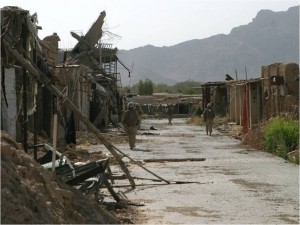In the spirit of our own Games of Duplicity, prominent Pakistani Irfan Husain upbraids Pakistan and her leadership, and concludes with the following:
Another factor that has thwarted a more effective response to the Taliban threat is Pakistan’s preoccupation with India. Generations of army officers have been taught that Pakistan’s giant neighbor is the real enemy, and this doctrine is reflected in the disposition and concentration of the country’s half-million-strong army. Troops have been trained to fight a conventional war on the plains of Punjab and Sindh. After 9/11, around 80,000 troops were deployed along the Afghan border, but even this number was insufficient to seal it. Currently, a military alliance between Afghanistan and India is Pakistani military planners’ worst nightmare. To thwart such a possibility, the Pakistani Army wants to retain the Taliban as proxies and is therefore reluctant to crush them.
Finally, Pakistan has not yet worked out a political consensus about who the real enemy is. Until the day he left office in early August, Musharraf was regularly castigated in the media as Bush’s poodle doing America’s dirty work by killing his own people. Pakistani TV networks are forever churning out talk shows in which so-called experts criticize the government for fighting fellow Muslims. They conveniently overlook the fact that these same Muslims are responsible for killing hundreds of innocent Pakistanis and Afghans.
In post-Musharraf Pakistan, the newly-elected government is struggling to find its feet. The coalition of the two largest parties has already split up. Nawaz Sharif, leader of his faction of the Pakistan Muslim League, has made clear his intention to talk to the Taliban rather than fight them. But Asif Zardari, widower of Benazir Bhutto and now president of Pakistan, has declared his intention to take the fight to the terrorists who threaten to seize control. In a recent article in The Washington Post, Zardari called this the “battle for Pakistan’s soul.” Clearly, this is a battle Pakistan cannot afford to lose.
In fact, a U.S. Marine Lt. Col. has recently gone on record saying that Pakistani troops were have at times actively resupplied the Taliban during combat operations.
Pakistani military forces flew repeated helicopter missions into Afghanistan to resupply the Taliban during a fierce battle in June 2007, according to a U.S. Marine lieutenant colonel, who says his information is based on multiple U.S. and Afghan intelligence reports.
The revelation by Lt. Col. Chris Nash, who commanded an embedded training team in eastern Afghanistan from June 2007 to March 2008, adds a new twist to the controversy over a U.S. special operations raid into Pakistan Sept. 3.
Pakistani officials strongly protested that raid, with a statement issued by the foreign ministry calling it a “gross violation of Pakistan’s territory.”
But fewer than 15 months earlier, Pakistani forces were flying cross-border missions in the other direction to resupply a “base camp” in Nangarhar Province occupied by fighters from the Taliban, al-Qaida and the Hezb-i-Islami faction led by Afghan warlord Gulbuddin Hekmatyar, Nash told Army Times in a Sept. 17 telephone interview.
He had previously alluded to the episode in a PowerPoint briefing he had prepared to help coalition forces headed to Afghanistan. The briefing, titled “Observations and Opinions IRT Operations in Afghanistan by a Former ETT OIC” and dated August 2008, has circulated widely in military circles. Military Times obtained a copy.
Nash said his embedded training team, ETT 2-5, and their allies from the Afghan Border Police’s 1st Brigade fought “a significant fight” in late June 2007 in the Agam Tengay and Wazir Tengay valleys in the Tora Bora mountains of southern Nangarhar – the same region in which al-Qaida forces fought a retreat into Pakistan from prepared defenses in the winter of 2001-2002.
“I had six [Marine] guys on a hill,” Nash said. “They weren’t surrounded, but in the traditional sense they might have been.”
At a critical point in the battle, the Pakistanis flew several resupply missions to a Taliban base about 15 to 20 kilometers inside Afghanistan, Nash said. None of the Marines witnessed the helicopter flights during the four days they were there, he said in a Sept. 19 email. Rather, the supply flights had been reported to them by Afghan soldiers and local civilians in the village of Tangay Kholl.
Versus this picture of active assistance to the Taliban, Pakistan has recently conducted heavy operations in Bajaur, and these operations are having a tangible effect inside Afghanistan.
[The] operation, which began in early August, has won praise from U.S. officials worried about rising violence in Pakistan and Afghanistan but has triggered retaliatory suicide bombings elsewhere in Pakistan. Some officials believe that the weekend bombing of the Marriott Hotel may have been a response to the Bajaur operations, which the army says have left more than 700 suspected militants dead.
Washington says the operation in Bajaur, rumored to be the hiding place of Osama bin Laden, the leader of Al Qaeda, appears to have reduced violence across the border in Afghanistan.
A Pakistani Army spokesman, Major General Athar Abbas, has said that Bajaur has been turned into a “mega-sanctuary” for militants and that the military is determined to flush them out.
But a rash of U.S. cross-border operations in neighboring tribal regions, including suspected missile strikes and a ground assault, underscore Washington’s concerns that Pakistan is either unwilling or incapable of rooting out extremists on its own.
There is still reason to be concerned. The intransigence of the world view and bureaucracy in the Pakistan military will be difficult to repair. Also, The Captain’s Journal still advocates the idea that the first place for NATO confrontation of the Taliban is Afghanistan. Security must be provided for the population in a counterinsurgency. However, if Pakistan can turns its attention away from India and towards the real threat – the Taliban – the effectiveness of the campaign will increase by an order of magnitude.




